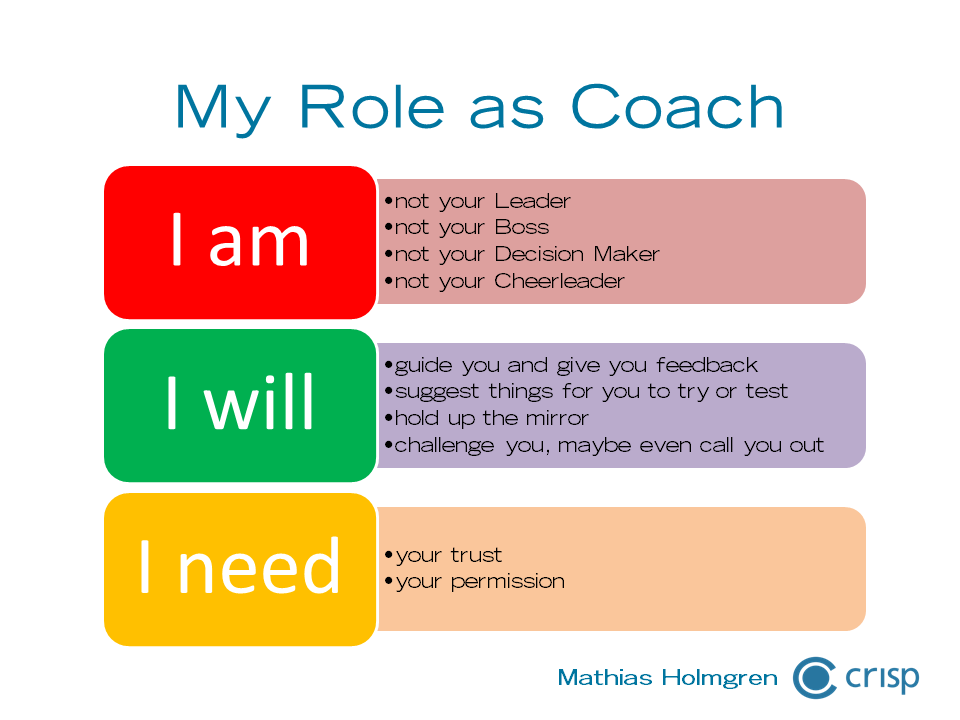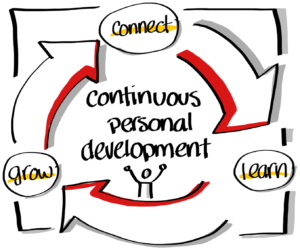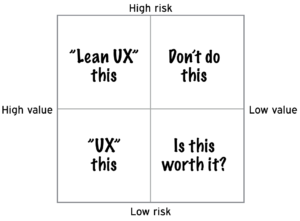 In the pursuit to automate testing to create faster feedback loops and build quality in, some teams forget the value of manual testing. In my experience, without manual testing (as well) we are toast.
In the pursuit to automate testing to create faster feedback loops and build quality in, some teams forget the value of manual testing. In my experience, without manual testing (as well) we are toast.
Crisp's BlogPage 7
from the Crisp Consultants
How to successfully join a team as a coach
 You’re coaching a new team! Woohoo! You have so many ideas! You’re going to help make the team’s world a better place! All the things that you’ll do! Then you get there. The music stops, and the frustration sets in. You’re trying to help but team members come late to the daily scrums, they don’t update the information radiators and they’re zoning out during meetings. You’re not sure what to do anymore. What happened? You feel undermined and unappreciated. Aren’t you the expert? Isn’t that why you got this team to begin with? Why won’t they let you help them?
You’re coaching a new team! Woohoo! You have so many ideas! You’re going to help make the team’s world a better place! All the things that you’ll do! Then you get there. The music stops, and the frustration sets in. You’re trying to help but team members come late to the daily scrums, they don’t update the information radiators and they’re zoning out during meetings. You’re not sure what to do anymore. What happened? You feel undermined and unappreciated. Aren’t you the expert? Isn’t that why you got this team to begin with? Why won’t they let you help them?
Let’s look at the journey of joining a team and how you can pave the way for a successful coaching experience!Continue reading
How to structure Ansible variables when provisioning infrastructure
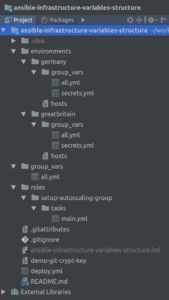 How should you structure your Ansible variables in playbooks calling cloud modules? Ansible has extensive support for variables at different levels (there are 21 different levels!).
How should you structure your Ansible variables in playbooks calling cloud modules? Ansible has extensive support for variables at different levels (there are 21 different levels!).
The inventory group_vars and host_vars offer enough flexibility for many use cases. However, when you are setting up cloud infrastructure, you don’t really have any hosts yet. Maybe you are setting up load balancers, instances, security groups and such things. Perhaps you want to setup the same things in several different environments (like “staging” and “production”). You want to re-use the same playbook, but adapt what it does by using different variable values in different environments.
In this post, I will demonstrate a way to structure Ansible variables in a playbook which pretends to setup a AWS AutoScalingGroup. I will show how you can separate the configuration for different environments by using a inventory directory. As a bonus, I will give you a neat trick to automatically load a extra variable file for each environment. We will use this to load a separate secrets file which is encrypted with git-crypt.
Interview with Dave Snowden, “What´s next for agile”
I had the opportunity to make an interview with Dave Snowden as he visited Crisp for his latest Master Class end of November, titled “What´s next for agile”. We explored the topic of What´s next for agile, new updates to the Cynefin model, now called Cynefin liminal. Check out the video below to of my interview with Dave (14 min).
Agile is increasingly becoming commodified and what are the opportunity for smaller Agile companies and anyone believing in the original Agile movement? (0:20). h “The key now is to produce new high energy efficient, radical, high value, innovations around the core of what Agile has become”
Stop Managing Bugs, Start Focusing on Quality!
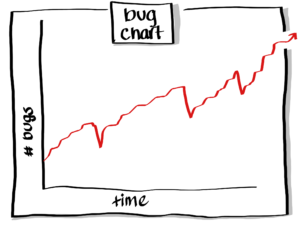 Do you have a long list of bugs? You definitely want to have a zero bug policy, but now you have all sorts of minors, majors, and criticals. You’re not really sure how to get to zero bugs (were you ever there to begin with?). You have spikes where you fix the bugs and your graphs show a steep downward drop, only for them to turn upwards again and reach new heights. Just maintaining the list of bugs is a full time job! To add insult to injury, when a team member finally gets around to looking at a bug, they usually find that it’s outdated, not reproducible or part of some long forgotten removed functionality.
Do you have a long list of bugs? You definitely want to have a zero bug policy, but now you have all sorts of minors, majors, and criticals. You’re not really sure how to get to zero bugs (were you ever there to begin with?). You have spikes where you fix the bugs and your graphs show a steep downward drop, only for them to turn upwards again and reach new heights. Just maintaining the list of bugs is a full time job! To add insult to injury, when a team member finally gets around to looking at a bug, they usually find that it’s outdated, not reproducible or part of some long forgotten removed functionality.
There has to be a better way! How can you shift the focus from managing bugs to ensuring quality? Here’s a system that’s easy to start using, and rewarding when you follow it.Continue reading
Agile coaching for the greater good
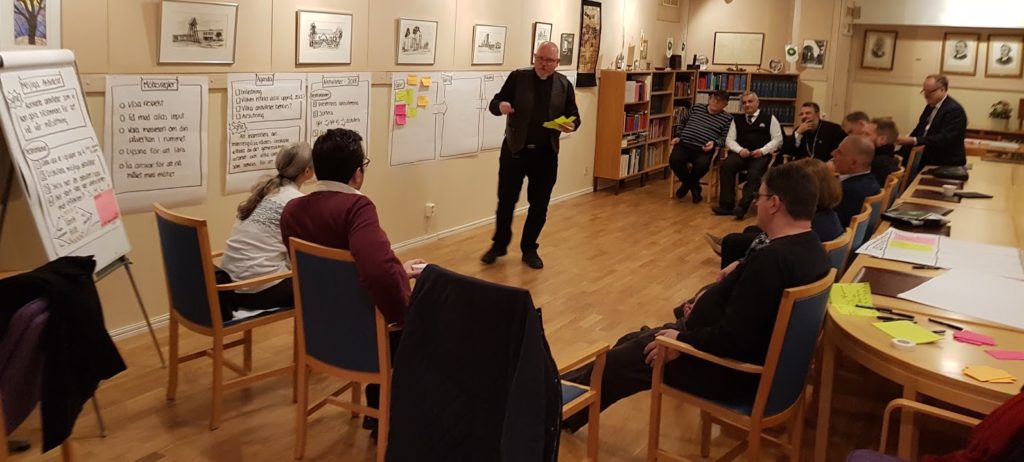
One of the most exciting aspects of working as an Agile Coach is applying what we know to other industries. Especially when what we do serves the greater good. We’re both always actively looking for opportunities to work with integration initiatives, and in this case we supported an initiative to improve integration of newcomers. Here’s how we facilitated the 2018 kick off meeting for Järfälla municipality’s Interfaith Council.Continue reading
Meat eater’s non-dogmatic guide to becoming more vegetarian
If you are a meat eater and you want to become more of a vegetarian (or at least eat more plant stuff and less meat stuff), and you kind of struggle with that because meat tastes good and you’re used to eating it, then this guide is for you! A short pragmatic guide for the
Continue readingHow to run Ansible tasks in parallel
When you use Ansible to provision hosts, running a task on a set of hosts in parallel is not a problem. You simply use the `serial` keyword in a playbook. See: http://docs.ansible.com/ansible/latest/playbooks_delegation.html#rolling-update-batch-size What about when you want to run a task several times in parallel, either on each host, or on a single host? A
Continue readingAgile Coach to Team Relationship
The role or function of an agile coach can be be a bit of a challenge to wrap your head around if it is new to you. Depending on your situation and on agreements with people in your organization, an agile coach could work with a wide range of responsibilities. It could be working closely
Continue readingTeam coaching in practice
 Have you worked with teams that don’t communicate well? Or teams that don’t collaborate? What about teams that deliver late or with poor quality? Or maybe teams that are in constant negative conflict?
Have you worked with teams that don’t communicate well? Or teams that don’t collaborate? What about teams that deliver late or with poor quality? Or maybe teams that are in constant negative conflict?
How do you tackle these issues? It might feel like you can fix everything by changing some of the people on the team. Before you do that, consider how you’ve set the stage for your team. Will removing and adding some people really solve all your problems? Or will the new members find themselves in the middle of a dysfunctional team, and end up unhappy and not delivering to their full potential?
Here are some of the things you can think about when you work with teams to create an environment where they can succeed.
Continuous Personal Development
For the past four years I’ve consulted for King as an agile team coach. It’s been a whirlwind of personal growth, learning about mobile games and meeting awesome people. I wrote about my biggest takeaways in an article on Crisp’s website. I am grateful for all the connections and insights that I’ve gained. I’m also
Continue reading10 kanban boards and their context – now in french
Yep! The collection of Kanban boards now is now available in french. Big thanks to Nicolas Mereaux who made it happen! Here’s the link to “10 tableaux kanban et leur contexte” (fr). (the english 1.5v is available here )
Continue readingOn Scaled Agile approches, interview with Yuval Yeret
Yuval is coming to Stockholm to teach a Scaled Agile class (Implementing SAFe) in January. I know Yuval from the Kanban community from a number of years back. We invited him because we know he shares the same pragmatic view on things as we do in Crisp. We made the interview in order for our audience to got to know him
Continue readingDo it for the kids
As climate scientists have long predicted, the world is experiencing a record amount of extreme weather events – droughts, hurricanes, wildfires, flooding, heatwaves, and extreme cold.

It’s hard to prove if any specific disaster is due to climate change, but that’s not important. The key point is the overall trend: climate change increases the frequency and severity of extreme weather events, and it’s happening really fast. This also creates climate refugees, political instability, and increases the risk of war. Basically, the world is becoming a less and less safe place to live.
This graph (source) is just for the US, but the pattern is worldwide:

The bad news is this will most likely keep getting worse over the next few decades – even if we were to completely eliminate all CO2 emissions right now. Climate change is like a huge flywheel that we’ve set in motion over the past century, and even when we stop spinning the wheel it will keep going for decades or more, due to inertia.
The common misconception about Lean UX
The role of software development is to produce software to solve a problem. The role of Agile software development is to learn as much about the solution as possible while developing, Agile does that mainly through ruthlessly begging for feedback, both on the product (e.g. sprint reviews, test-driven development and continuous delivery) and on the process (e.g. Scrum/Kanban boards, sprint retrospectives and standup). In between all these feedback sessions, you do ”normal” software development.
The role of user experience design (UX) is to produce a design to solve a problem (through user research and interaction design, of course). So, software development and user experience design go hand in hand, completing each other. Design and build.
The common misconception is that Lean UX also shall produce a design solution to a problem.
This is not the case. The role of Lean UX (and its progenitor Lean Startup) is to learn, but learn as much about the problem as possible. Lean UX does that through ruthlessly validating assumptions about the problem, the customer, their needs, the proposed solutions and the success metrics. Lean UX and Agile go hand in hand as well, learning about the problem and the solution, before, during and after development. In between all these validation sessions, you do ”normal” UX.
Min familjs CO2 kompensation för 2017
Jag skrev tidigare i år under Zero Carbon Manifesto, där jag lovar att komma ner till 0 i min klimatpåverkan, eller kompensera för den del jag inte lyckas med.
Så här i mellandagarna tänkte jag att det är dags att räkna hur jag ligger till för i år!
Läs om hur min familjs samlade utsläpp av CO2 kompenseras till en kostnad av 78 kr i månaden.
Introducing the Agile Pill
Through the years we have at Crisp repeatedly been confronted with the question “How can I become Agile?”. We have checked with coaches outside Crisp and they give us the same picture. People want to become agile and they want it now. It has become obvious to us that there is a need for a quick fix. Hence the Agile Pill.

Remote keynote offer (because the world needs less business trips)
OK here’s an offer to any conference organizer in the lean/agile/tech/climate space. I get a lot of requests to do conference keynotes, which I’m grateful for, but unfortunately I have to turn down the vast majority. I limit long-distance travel for family reasons, and also for climate reasons (although I confess I’m in Thailand right now as I write this…. hard to be 100% consistent…).
Now I’m thinking: Why should something as mundane as physical transport get in the way of participating in a great conference? And, in this world of catastrophic climate change, shouldn’t most business trips be replaced with remote participation?
My hypothesis is that it’s possible to remote-participate effectively in a conference – to do a keynote or talk, participate in workshops, even hang out with people in the hallway. I’ve tried this a few times using video conference and telepresence robots. In fact, 4 years ago I was sitting on this same beach in Thailand, remote-participating in a Spotify event in Stockholm using a Double (see “What it feels like being an ipad on a stick on wheels“). That was fun and a bit clunky, but it was 4 years ago so I bet the telepresence robots have come a long way since then!
So here’s my offer:Continue reading
Here’s something you can actually, really do about climate change
As the devastating consequences of climate change become increasingly obvious (flooding, fires, storms, drought, melting icecaps, rising sea levels, etc), the question on most people’s mind is “what can I actually, really do about it?”. Well, listen up. The most obvious minimum first step is to eliminate your own personal carbon footprint, and become climate
Continue readingAgile – where are we at? Slides from my keynote at Agile Tour Bangkok.
Here are the slides from my keynote “Agile – where are we at?” at Agile Tour Bangkok i November. Here’s the abstract:
Everyone is talking about Agile. I stumbled into this 15 years ago and have been living and breathing Agile since then, seeing it grow from a small movement within software, into an industry-wide revolution and then gradually become mainstream. More and more companies around the world, even big traditional companies, are turning themselves inside out trying to be Agile. Now it’s time to take a step back and reflect. What is going on? What is this all about? And where is it headed?
The CO2 emissions from this trip were offset using Trine and GoClimateNeutral.
Sample slides:

Case: Real World SAFe at SimCorp
Not every company starts from a green field. Many carry legacy. So how do you kickstart Agile and get traction in an organisation with scale? We can learn lessons from SimCorp, a successful provider for asset management solutions, who runs 500 developers across 4 sites and went from 0 to 8 release trains in 14 months. Here’s
Continue readingThree “no brainer” engineering practices for developers
In modern software development there are three development practices that everyone should strive to apply:
- Automated testing
- Pair or mob programming
- TDD, test driven development
After many years of using and researching these practices in the development community there is no longer any question whether these engineering practices bring value or not – they do. It’s not a matter of opinion, it’s a matter of fact. We know that now.
New book being written online – Facilitation tricks and techniques
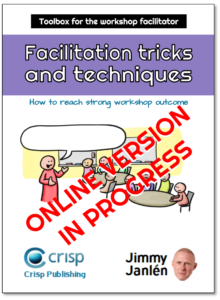 Last time I wrote a book (Visualization Examples) I decided to do it publicly online. That was a fantastic experience, which I also wrote a blog post about. It was great fun and I got tons of valuable feedback.
Last time I wrote a book (Visualization Examples) I decided to do it publicly online. That was a fantastic experience, which I also wrote a blog post about. It was great fun and I got tons of valuable feedback.
Now I’ve started to write a new book and I’ve decided to have the same approach. It’s currently titled “Toolbox for the workshop facilitator – Facilitaion Tricks and Techniques (How to reach strong workshop outcome)“.
The book is far from finished and it might take me another year to finish it. But I still want to invite you to read it now and to help me make the book even better.
Fika Stories 2 – The Policy-Debt Trap
November in Sweden: Blä! The sky is impossibly low and grey, it’s pitch dark at 4 pm, freezing, and then everyone gets cold. Especially men: they get man-cold. There are also situations when your Kanban gets a man-cold (though it doesn’t need to be November for that): it’s not really dying, but it feels like
Continue readingCore Protocols – effective communication
– Having rules for communication is stupid!
– What was your intention with calling the rules stupid?
– Well, I’m sorry, I didn’t mean anything negative towards you, of course. I just don’t find such rules necessary at all. We have been communicating with each other since we were small.
– Okay, I understand what you are saying. But, hear me out…
Slides from Devops Greece 2017
Just got back from Athens and Devops Greece where I talked about “Using Kanban in the field, and how we got management buy in to do so” Two key takaways are: Shift leadership behaviours, in order to shift your culture. The good news is: You can all exericise them, they are not personality traits. The invisible
Continue readingFika Stories 1 – “Help! Our Kanban died!”
In Sweden, we love to ‘fika’. Fika requires you to take time to sit down and sip coffee (usually strong and black) with your colleagues to chitchat about this and that. Visiting different organizations, I tend to fika a lot and hear all these stories about how things are going. Today, I’ll like to share
Continue readingHow to Train to Kanban
I have the pleasure to be invited back to I’ve hosted a workshop about “how to train to Kanban” at the Lean Kanban France 2017. The session was specially designed for you who is about to start training one or several teams, or who want to become better at training Kanban. It builds on the “Kanban
Continue readingConsent Decision Making – How to take effective decisions collaboratively
In this series of blogs, I am writing of my experience of practical applications of Sociocracy 3.0 (S3) patterns in teams and organizations. In the first blog, I wrote about My journey of finding and applying Sociocracy 3.0 (S3). There are many cool patterns in S3 that I have been using with great success as an Agile organizational coach so far. In this article I will cover the pattern of Consent Decision Making:
In contrast to consensus which focuses on reaching an agreement, consent focuses on intentionally checking for reasons not to do something a certain way. An objection is an argument that reveals why doing (or continuing to do) something, impedes or misses an opportunity to improve flowing value somewhere in the organization. Reaching consensus is often very time consuming and has the risk that one single person can block the whole process when unanimity is sought. Continue reading


